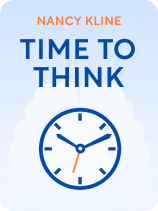

This article is an excerpt from the Shortform book guide to "Time to Think" by Nancy Kline. Shortform has the world's best summaries and analyses of books you should be reading.
Like this article? Sign up for a free trial here.
How can you help someone overcome an assumption that limits their thought and action? What role does your silence play in the process?
Nancy Kline asserts that the key to evoking high-quality thinking in others is to listen to them well. She provides a step-by-step process for conducting a productive conversation, or a thinking session, which maximizes the quality of both listening and thinking.
Let’s take a close look at Step 4 in the process: Ask an incisive question.
The Incisive Question
The fourth step in the thinking session process is to ask the thinker an incisive question that challenges their limiting assumption (a belief that the thinker holds that curtails their ability to identify or implement the best course of action). According to Kline, this is a very specific question that’s based on the statements they’ve made about their goal and assumption (which is why it’s so important to memorize those). This question replaces the thinker’s limiting assumption with an assumption that frees their thinking, and, as with the other aspects of the thinking process, it needs to be identified by the thinker.
To help the thinker identify their liberating assumption, ask them what the converse of their limiting assumption is. Do not try to identify this for them. Again, the thinker chooses their specific words for a reason because those words are more meaningful to them than any other phrasing would be. Always use the thinker’s words rather than your own.
For example, if the thinker wants to pursue a career change but they’re afraid to try, and their limiting assumption is “It’s not okay to fail,” your first thought might be that the liberating assumption would be “It’s okay to fail.” But if you ask the thinker what the converse of “It’s not okay to fail” is, they might instead say “Failing helps you grow.” So then, using their words, incorporate that converse assumption directly into your incisive question: “If you knew that failing helps you grow, how would you go about changing your career?”
(Shortform note: Kline’s process of asking incisive questions is a type of coaching, or a way of guiding and supporting members of an organization to help them develop already-existing skills. This is distinct from a managerial approach, which is more appropriate when members of an organization are gaining brand-new skills or tackling a role or task they’ve never encountered before. Employees in this position might not have the knowledge or skills needed to identify limiting assumptions and form incisive questions, so they would need more direct guidance. However, if your employees already have a strong foundation for what you’re asking them to do, a coaching approach could elevate their understanding and performance.)
Note that simply saying “That’s not true” won’t dispel a limiting assumption. To you as an outsider, the core assumption “My spouse might leave me if I am honest with them” may seem absurd, but, to the thinker, it’s a very real threat. It’s important that you take it seriously and not dismiss their feelings.
(Shortform note: Contradicting a person’s limiting assumption not only dismisses their feelings: It can also be redundant, as the thinker may already know that their assumption isn’t true but still believe it. Research shows that people often hold beliefs they know to be irrational and that the cognitive process of identifying a thought as irrational is separate from the cognitive process of correcting that thought. Thus, pointing out that a thought is irrational is likely to be unproductive because it targets the wrong cognitive process.)
Once you’ve identified the assumption, work with the thinker to create an incisive question. Use the following formula: “If you knew,” plus [the liberating assumption], plus “how would you [go about reaching your goal]?” Then ask the thinker the question and listen to their response, says Kline. You should pay close attention and not interrupt, even when the thinker is quiet for a long time. After they answer the question, ask it again. Allow them to answer, and then ask yet again. While the question remains the same, the thinker will continue to generate new ideas on each occasion. Continue to ask the question until the thinker is certain they’ve answered it fully. When they’re out of ideas, you can move on to the next step.
(Shortform note: While repeating a question can elicit new ideas, it may also make the responder feel like there’s a certain “right” answer you’re trying to get from them, a phenomenon known as “suggestive questioning.” This is another reason it’s vital to use the thinker’s own words in the question and to avoid adding your input as they talk.)
Write Down the Incisive Question
The fifth step of the thinking session process is simple: Have the thinker write down the incisive question they’ve identified, verbatim. You might find that they struggle to remember it precisely, so make sure you help them get it exactly right. Even though you’ve asked them the question several times already, it’s easy to forget once they leave the session, so they need to write it down so they can refer back to it as they continue working on their issue.
(Shortform note: Writing down the question is useful to the thinker, not only because they can refer back to it later, but also because the process of writing down your thoughts helps clarify and concretize them, helps you think about them on a higher level, and makes it easier to take action on them.)

———End of Preview———
Like what you just read? Read the rest of the world's best book summary and analysis of Nancy Kline's "Time to Think" at Shortform.
Here's what you'll find in our full Time to Think summary:
- That what and how we think determines everything we do
- Why the quality of your thinking depends on how well you listen to others
- A step-by-step process for taking on the role of the listener






